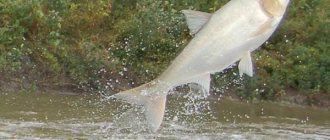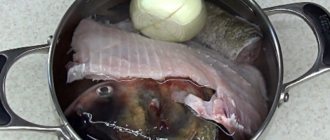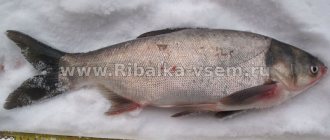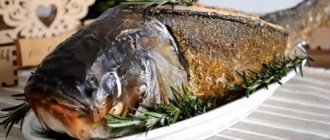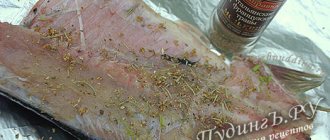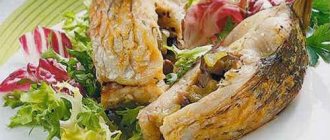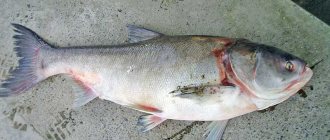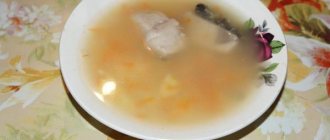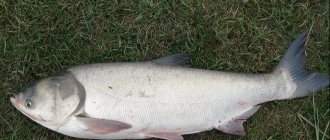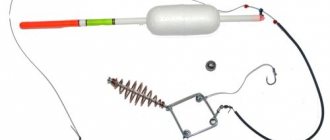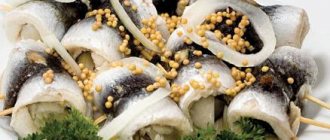Silver carp is a filter fish. It is often bred as an addition to other fish species, as a water cleaner. After all, she passes water with the help of her mouth, which is located on her head, and is visually similar to an inverted jaw, the upper part of which is shorter than the lower: this arrangement of the mouth helps it filter the water in which it catches phytoplankton, for example, during the bloom of blue-green algae , and zooplankton. Since silver carp meat is considered valuable and dietary and contains not only vitamins, but also Omega-3 and 6 fats, it is now bred in ponds and as the main fish. He gets along well with Grass Cupid.
There are three types of silver carp bred: white, hybrid and motley. They love a warm environment and are not in the active zone during the winter. For spawning they need a temperature of approximately 20 ° C. On average, in nature they live 5-7 years, can grow up to 1 meter in length and gain weight depending on the conditions of their detention; they can gain weight up to 35 kg. It is of interest to fish farmers due to the fact that it not only has valuable meat, it also quickly gains weight and at the age of 3 years can weigh 5 kg.
Silver carp
Its sides are flattened, its body has small scales, at the age of three it has a silvery color, older fish have a bluish tint, and a dark stripe on its back. The eyes are deep-set, the jaw is raised upward. sexual maturity depends on the temperature in which the fish lives: in warm regions - at the age of 3-4 years, in cold regions 5-6. The fry feed on zooplankton until they develop a filter apparatus on their gill arches, after which phytoplankton becomes their main diet.
Nutrition and lifestyle
Silver carp, like all its other species, is a pronounced schooling fish with a clear age hierarchy. Avoids strong currents and hard bottoms. It adheres to moderate depths with an abundance of vegetation. Tolerates a significant temperature range from 0 to +40°C. In winter, it goes to the pits, where it lies “hibernating” next to carp and crucian carp. Copes well with low oxygen levels in water.
Silver carp is a herbivorous fish, often jokingly called “underwater reclamation fish” or “water goat”. Food preferences depend not only on age, but also on species (see table).
| Age/species | Main food | Secondary feed |
| Whitebait of all types | zooplankton | zoobenthos |
| Young animals | zooplankton | phytoplankton |
| White | phytoplankton | zooplankton, aquatic plants, detritus |
| Motley | zooplankton and zoobenthos | phytoplankton |
| Hybrid | feed mixtures, phyto-, zooplankton | detritus, aquatic plants, zoobenthos |
Fry and fingerlings require a lot of nutrients for rapid growth, so they prefer the smallest aquatic animals and crustaceans (zooplankton), which contain huge amounts of protein. The same menu is typical for adult bigheaded carp.
As the standard species matures, it undergoes significant physical changes associated with the fusion of gill rakers into an effective filtering apparatus. This is why the fish switches to feeding on phytoplankton (single-celled algae).
Due to this feature, silver carp is widely used in aquaculture to prevent or eliminate the consequences of the rapid proliferation of blue-green algae (water blooms).
The hybrid species is a universal eater and easily adapts to special feed mixtures that provide intensive weight gain.
To learn more:
Description of bluefish fish: habitats and fishing methods
Growing conditions
Silver carp prefers a muddy bottom to live in, as well as a warm temperature - about 25 ° C. They also love the sun and a lot of vegetation growing in the pond. Loves deep bodies of water, suitable depth is 3-4 meters. In the morning and evening, silver carp swim in shallow water, and during the day they prefer to stay in depth. There are differences in the diet of the three species: the white one feeds mainly on phytoplankton, the motley one on zooplankton, which gives it rapid weight gain, but the hybrid species loves what the first two species feed on.
to grow silver carp in a pond by separating them by age; this type of breeding will help avoid diseases and improve fish breeding. The size of the pond for breeding this type of fish should be from 200 to 300 m2. The pond must be equipped with flora so that during spawning, from May to June, the eggs have something to attach to. The number of fish per 1 hectare should be no more than 900 individuals, with an increase of no more than 2 kg. In the fall, sexually mature females are selected for future spawning and placed in a separate reservoir.
To grow such fish for business, you must not forget about the following factors:
1. When the temperature drops below 18 °C, the fish stops gaining weight, and everything it eats goes into energy to maintain its strength.
2. Water bodies must be cleaned regularly. Disinfection measures should also be taken to prevent waterlogging. These two factors will allow your fish to be healthy and not get sick.
3. If you are developing your business in fish farming, then your income from agricultural activities should be 70% or higher of your total income, since in this case you have tax breaks on agricultural products.
For business, it is recommended to grow white and hybrid silver carp; they are more profitable. The fry are first deposited at the age of about 6 weeks. After two years, the fish are transplanted into a feeding pond, which should be prepared in advance by fertilizing its vegetation with saltpeter. By increasing its growth, more crustaceans will appear, which will give the fish good food for gaining weight.
Types of silver carp
The common, or white, taxon is the base taxon in the genus and has the largest intraspecific population. Also widely known is the southern (spotted, motley) silver carp (Hypophthalmichthys nobilis), which is native to China. It feels especially good in natural reservoirs and specialized farms in the Songhua River basin, from where it was accidentally introduced into the Amur as a result of severe floods in the 1950s.
In the new location, the taxon successfully acclimatized, spreading both to the upper and lower reaches of the river and to the Amur Estuary with a water salinity of 9-10 ppm. This circumstance became the main reason for the emergence of doubts - sea or river fish is silver carp.
Silver carp
In fact, this is a freshwater representative of the ichthyofauna, capable of making feeding migrations to the slightly salty and well-warmed sea shelf with depths of 3-10 meters.
The white and motley species coexist peacefully in the same body of water and can form an independent hybrid form, which retains the acquired traits of the “purebred” parents over generations. In addition, the new taxon has improved morphology and climate resistance, which makes it a promising object for pond cultivation in the former Soviet republics, Russia and throughout Europe.
Bighead carp
It is distinguished by accelerated growth, shortened intestines, a huge head (up to 50% of body weight) and a shorter body with an olive back. The main heterogeneous color is characterized by scatterings of dark small spots throughout the body. Immature young animals have golden-colored sides, which become silver-gray with age. The eyes are located below the level of the mouth line and have a wider set. The keel on the light belly is less pronounced; it is clearly visible only between the ventral and anal fins.
Bighead carp
Hybrid silver carp
Adapted to living in cool water. It has reduced head parameters (15-20% of the total dimensions), silver color, characteristic of the white species. At the same time, it grows quickly, which is typical for a variegated taxon. An important individual characteristic of a hybrid is high quality meat, peaceful disposition, calm behavior, and resistance to stress.
To learn more:
Description and characteristics of European grayling
Thanks to these morphological factors, the fish is compatible with all representatives of the ichthyofauna and is capable of steadily gaining weight even in the unfavorable microclimate of the reservoir. Among the hybrids, albinos with a golden-honey color are often found. The largest amount of yellow-orange pigment is found on the forehead, back, and fins.
Hybrid silver carp
Spawning
In Ukraine, reproduction of bighead carp occurs through artificial incubation of eggs and subsequent rearing of fry. The female, ripe for laying eggs, is stimulated with drugs (pituitary injections) that accelerate the growth of the ovaries. After the females, previously caught and placed separately, the eggs are taken and very carefully squeezed out of them into a clean container and fertilized with the milt of the male using a goose feather. Fertilized eggs differ from unfertilized eggs in a brighter color; after this process, the eggs are washed with clean water to remove any remaining blood and other dirt. When the eggs have swollen to 5 mm, they are placed in an incubator. The larvae appear after a period of time from several hours to a day. When the larvae hatch, they are transplanted into special cages, where they develop and begin to feed on zooplankton, such as daphnia or cyclops. The survival rate for artificial cultivation is 50%. Two-week-old fry switch to feeding on phytoplankton.
Growing silver carp in a pond is an interesting and slow process, so you need to be patient to get the desired result. If at first your business does not pay off, then you can introduce additional income: rent out a pond for fishermen to recoup part of the costs.
Silver carp fishing
There are some difficulties when selecting baits due to the peculiarities of the diet of planktivorous fish. To catch silver carp use:
- durable carp rods;
- powerful inertia-free reel with a friction brake and an option to instantly turn it off (bytner);
- monofilament with good shock-absorbing properties, thickness 0.3-0.35 mm;
- short leashes (10-15 cm) made of nylon or fluorocarbon fishing line with a diameter of 0.14-0.2 mm;
- two or three medium hooks No. 10-14;
- drop-shaped or round sinker.
To learn more:
Description and characteristics of Baikal grayling
The main element of the equipment is the “silver carp stick” - a special installation in the form of a diamond-shaped frame onto which a cylinder of a special dust-producing bait is attached (sold in fishing stores under the general name “technoplankton”).
After casting, the pressed structure of the bait begins to intensively soak, creating a food cloud of tiny plant-animal suspension. In the process of feeding water filtering through the gills, the fish accidentally sucks in the hook and is hooked. Instead of technoplankton, you can use a spring feeder with porridge or dust to catch carp or carp.
Features of catching silver carp in winter
Silver carp or silver carp fish belongs, of course, to heat-loving relatives from the carp family. This is especially noticeable in the increased bite of silver carp only in very warm water, which is also typical for carp. Obviously, due to many similar traits and characteristics inherent in the cultivated carp, silver carp is also called “silver carp.”
Silver carp are also highly thermophilic during the spawning period, which is possible for these fish only when the water temperature reaches plus 18-20 degrees, if you use the Celsius scale. Another very characteristic feature of silver carp is their ability to purify blooming water, turning it from muddy and green to completely transparent and clean. Crafty silver carp have learned to strain and filter out flowering greens, simply feeding on this plant “plankton”. This makes this fish similar to grass carp, which is also a cleaner of reservoirs, but from larger vegetation.
Since winter fishing is impossible in Asian rivers, so to speak, by default, this fish is caught in the rivers and bays of the Amur basin in winter. Silver carp have also taken root in the basins of the Kuban River and in the estuaries of the Aral Sea. However, now in many other reservoirs, silver carp have become an ordinary fish, desired as a trophy, tasty and even medicinal and dietary in its nutritional and gastronomic qualities. Moreover, this is probably the only freshwater fish with a high fat content, like fish that inhabit the seas. And what is surprising is that when eating silver carp meat, patients and those on a diet lower their cholesterol levels, despite the high content of fish oil in this fish.
Wherever silver carp have assimilated, it catches best in winter in reservoirs with relatively warm water, even under ice. But this does not happen everywhere. In some reservoirs, ice springs gush from the bottom, and the water in such places is on the verge of freezing due to the temperature regime. On the contrary, ponds and reservoirs at nuclear power plants, the water of which is used to cool the nuclear reactor and then returns back, warmer than when it was taken into the coolers of the nuclear power plant, are the most preferable for breeding silver carp. Moreover, during the flowering period, which usually occurs in July-August, silver carp will keep the water in the pond clean and clear. But in such reservoirs, winter fishing is usually done with summer gear, which includes a feeder and a float rod. Only in the bays on the opposite side of the cooling pond are silver carp caught from the ice.
The most common winter fishing for silver carp is in the so-called “platniki”, where winter fishing rods catch specimens weighing up to 5-8 kg. However, this will not surprise experienced summer fishermen who catch silver carp in the eriks and bays of the Kuban, as well as in the estuaries of the Aral Sea, where specimens weighing up to 50 kg are not uncommon.
In their habitats, silver carp choose places with a muddy bottom and dense vegetation, where they find plant food and various larvae to replenish protein. The bighead carp is more prone to animal food. Its close relative, the silver carp, prefers more plant foods, which plays an important role when choosing bait for fishing.
The choice of gear for catching silver carp from ice is small. Most often, a classic winter fishing rod is used, but with much stronger equipment than for catching ordinary winter roach, bream and even bream. After all, very large fish can bite, and silver carp are strong on the hook, like carp and carp. A float fishing rod with equipment that uses a pop-up float is also used. Sometimes the most successful rig is a bottom with a tackle made from a combination of cylinders of technoplankton or makukha, as bait, and hooks with mounted foam or the same technoplankton, makukha or corn grains.
Spinning silver carp is not practiced. If he gets caught on a lure, it’s most likely purple. There is, however, a more modern method, which is also used in paid ponds for trout fishing. And we'll talk about this in the next chapter.
